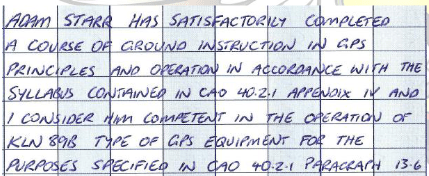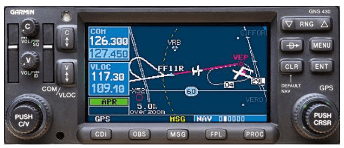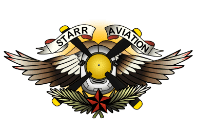You also need to have the background knowledge of how the system works. In this day and age you really should be familiar with GPS and GLONASS (as I reckon you probably already use both on your phone!), cross-checking waypoints and flight plans, what PBN and RNP both you and the machine are and why, the accuracy/errors/reliability/coverage/range of the system and a few other things described in the appropriate syllabus.
Syllabus? What syllabus? Back in the day (groan, yes here we go!), when these PFM boxes were new,there was a separate course you had to go through in order to use it. We are talking CAR5 licences here and the old Command Instrument Rating. The syllabus then was hidden in the CAO and, once you had done the course you would get something for your logbook like this:

That was evidence I had completed the course and could use the GPS (it also happens to be evidence that I actually had a paperlogbook at some stage!). It also mentions the type of GPS and enforced further learning when you moved on to another type.
Now that we are in the times of the Part61 licence things have changed subtly. If you start your training now to become a pilot,you will automatically be taught all you need to know about GNSS systems as well as how to use your particular little box. This is decreed in the MOS with the knowledge unit of PNVC and the practical units of RNE and NAV. These are at PPL level so every pilot should have that skill/knowledge set and the NAV unit is also prescribed for RPL nav endorsement so that skill/knowledge set should have been taught and examined there as well.
Pretty straight forward so far. Now for the grey area! What if you had a CAR5 licence (without the CAO signoff) and you transitioned to a Part61 licence? You can tell if this has happened -well you will know your own as you did it yourself by providing a few reams of paperwork to CASA. You can tell if it has happenedto someone else as back on page 17 of their licence it will have these telltale little marks:

This may mean that you have slipped through the cracks of the syllabus change. When someone presents to me for this update,I simply run a course to the current MOS standard and then provide certification. That means that person is now equivalent to both of the other examples –a CAR5 conversion with the CAO certification and a straight Part61/MOS licence-holder.
You also NEED to be competent on this by law. CASR 61.385 states that, in order to exercise the privileges of your licence in an aircraft you MUST be competent in “operating the aircraft’s navigation and operating systems” as well as many other items.
Now that we are certified, is our aircraft? Was the little PFM box installed to a particular TSO? Is it of an appropriate type? These can be hard questions to answer and will involve a bit of legwork on you part. It is too much for this article,but I will delve into it more in another article. You can get a fair idea of your aircraft and avionics capability by just looking at the Maintenance Release and seeing if it is certified for IFR. You can (and I suggest if you are going to use GNSS that you should) also go through CAO 20.91 and examine where your aircraft fits. Another handy little place to look is in AIP GEN 1.5 and see if you have the right equipment to satisfy your operationas well as CAO 20.18 Appendix IV.
Let’s assume that you are now proven qualified to use themagic and the box/es in the aircraft are appropriately certified. Now can you use your GPS??
In most discussions,I have found the references revolve around what is in the AIP. To take it back a step further, I have even had discussions around the relevance of AIP. I was once told that the “I” in AIP stood for “Information” and, as such, was not binding and was for information only. I am always open for a good debate so let’s discuss this point before moving on. Firstly, if you have a look at some of the regulations (e.g. CAR 174D) they state that, with a regulatory basis, CASA may issue further instruction on how to navigate. I take that to mean AIP. Now I know that is an Airservices publication and not a CASA publication (as a debater once pointed out) so does not fit the letter of the law. But if we don’t take it to mean that then it must mean that AIP isjust for “Information” and can be ignored if we wish –including AIP GEN 1.5 that we discussed above so we don’t need TSO and can navigate on our iPads; we don’t need to obey the blue lines on the maps that are also considered part of AIP, in fact we don’t even need to use the standard phraseology or abide by any of the many requirements in ENR 1.1. I don’t subscribe to that theory (Isuggest you don’t either) and take AIP as a regulated direction from CASA.
Another point in some discussions revolves around phrases like “sole means” or “primary means”. These terms were around a while ago but seem to have faded a bit. Now it just seems that you need to be able to navigate by one of several methods.
AIP ENR 1.1 para 4.2 talks about navigating under the VFR and is oft quoted by people believing it states a VFR pilot must navigate by reference to ground or water. The other part of that same paragraph (AIP ENR 1.1 para 4.2.1(a)) follows on to say that you could also navigate by any of the methods inpara 4.1.1 except when operating at 2000’ or below (which is sensible). If you now go to para 4.1.1 that talks about IFR navigation. That means that a VFR pilot can navigate by visual reference to the ground or water OR by any IFR method –including GNSS which is an approved area navigation system.
The key here is that the GNSS, if used, must meet the performance criteria (i.e.TSO as discussed before)and you must be competent in its use which you would be under CARS 61.385 if you are flying that aircraft.
You can apply this to your own situation but lets just take a simple example. A VFR PPL holder goes and hires an IFR capable aircraft. This happens in a lot of places where the same aircraft is used for both IFR and VFR work. The PPL holder has been told that they can’t use the GPS and has therefore never been instructed in its use. The PPL holder then cannot hire the aircraft as they are not deemed competent under CASR 61.385. This means that the PPL holder needs to make sure they have the underlying knowledge by syllabus as described above (CAR5, Part61 or the grey area licence) and then be competent in the use of that unit. Once that has been achieved,they can quite happily and legally use that GPS to navigate.
So next time you go and fly, see if youhave a GPS, and satisfy the above requirements and, importantly, make sure the navigation database is up to dateon the unit. If all checks out,then go for your life.
Now, shouldI use my GPS?You still want to keep basic skills alive so practice them aswell. The two skills should go together–don’t rely on the GPS to the detriment of map-reading skills BUT also don’t rely on map-reading to the detriment of GPS skills!There are also a few caveats that are in AIP (as well as in any reasonable pilotsmind) about navigating above SCT cloud VFR. These warnings should be heeded and careful decision-makingprocesses and risk analysis performed before attempting this sort of flight. You can do it, but you had better make sure you can get back down! Position fixing is not an issue as it is not required under AIP (if using map/ground it needs to be every 30 mins, if by VOR 2 hours, but not needed for an area navigation system). It is prudent, however,to still put pinpoints on your map/EFB at regular intervals (by whatever means) and do your CLEAROF checks just in case something does happen.
Lastly, you also need to know what to put in your flight notifications which is in the AIP and for IFR pilots you need to be aware of quite a bit more of what you can do and what you need to notate. Both of these will be too long for here so will be the subject of separate articles.


 Download File
Download File